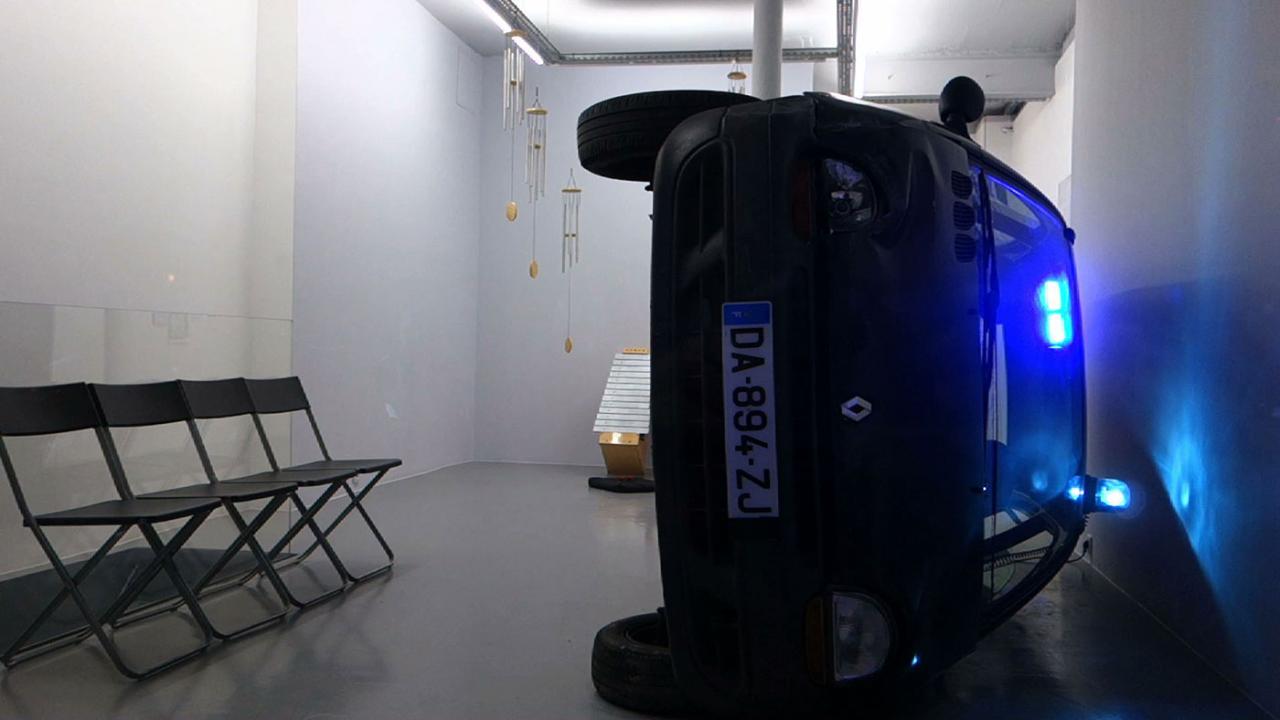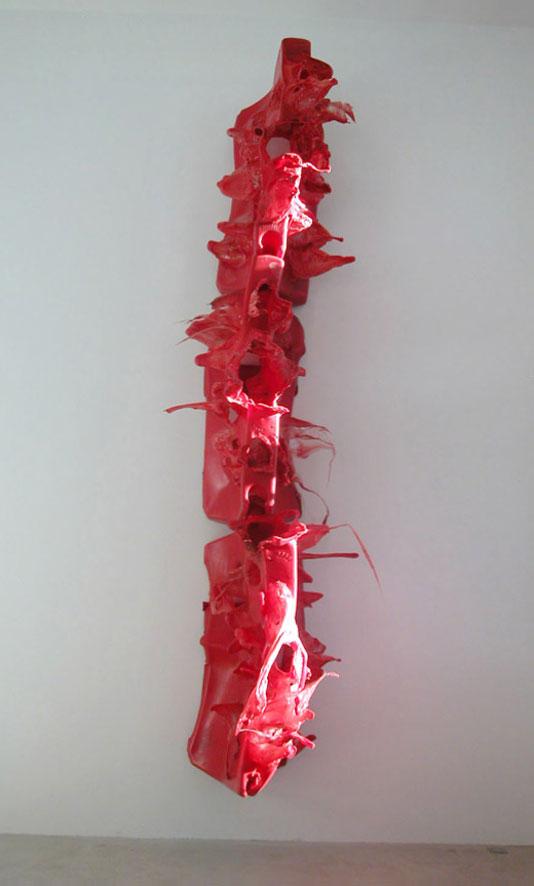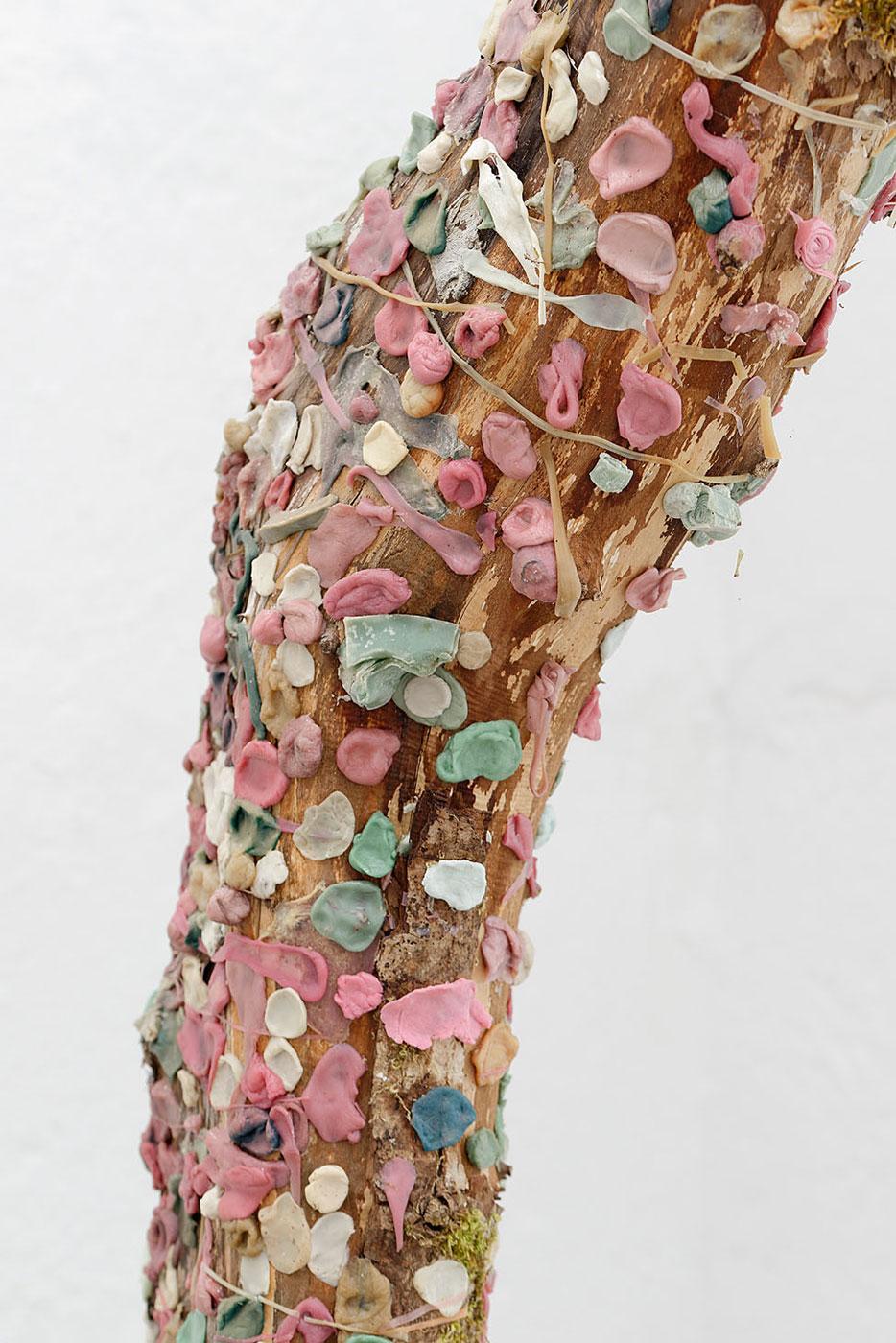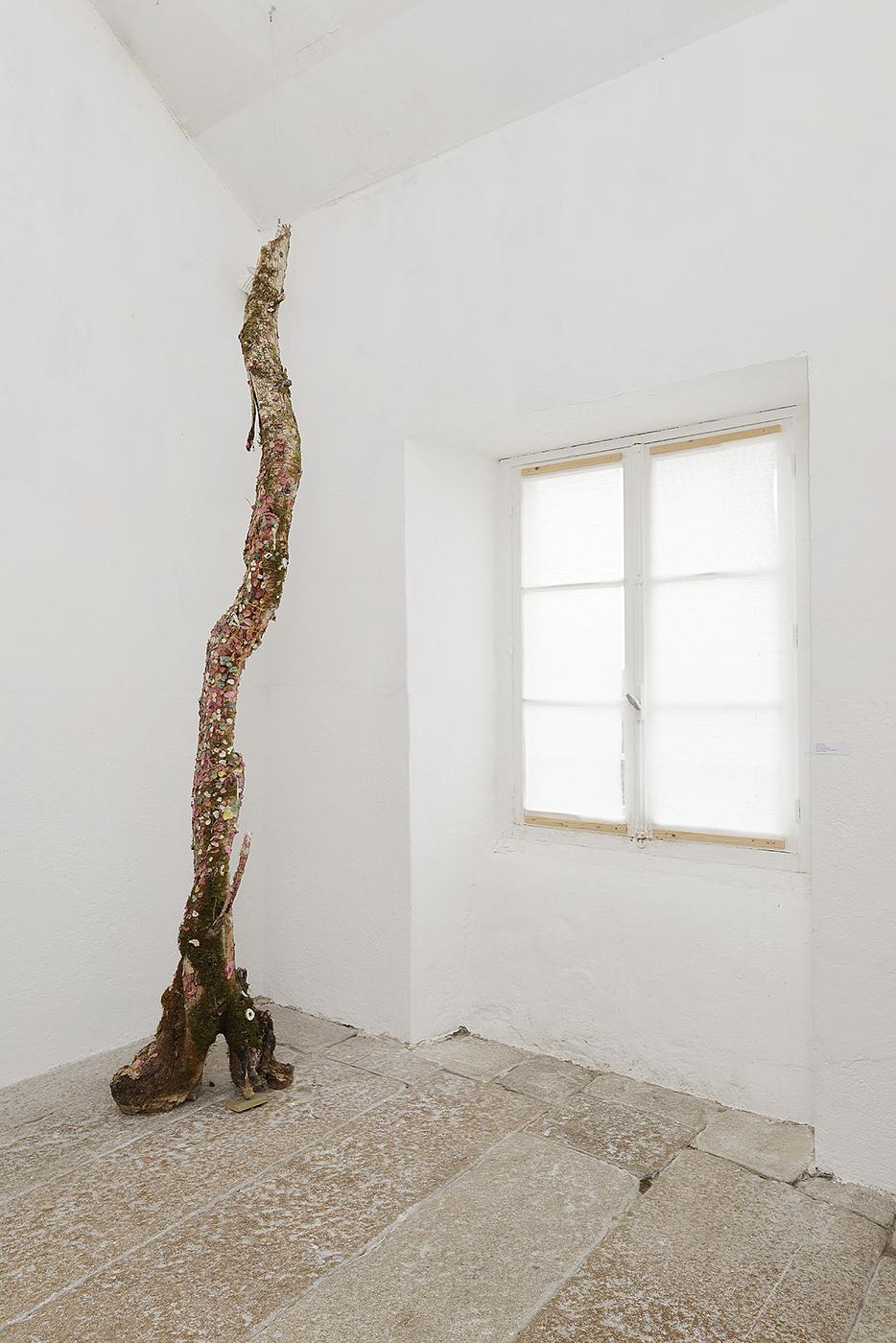A Policeman who was an Aesthete
A Policeman who was an Aesthete
A written fable based on three works selected by the author from the collection of Documents d’artistes Provence-Alpes-Côte d’Azur.
Once upon a time, in a low-lying valley, there was a policeman who liked taking photographs of accidents. As a boy, he would swim like a fish in the local river, amaze his young friends on a vaulting horse, win every badminton tournament at his school, and ride the ponies at the nearby riding school with all the style of a Navajo chieftain.
“That lad has everything you need to have a future in Security”, said his father, who had climbed his way up through the ranks to become a sergeant, and dreamed of a similar career for his son.
No sooner said than done, and the young man was summoned to enrol in the police school, as soon as he had mastered his conjugation tables and basic equations. First of all, he tried to join a mounted regiment, but he failed the entrance exam for somewhat mysterious reasons, which plunged him into a state of despair for months. That failure was hard for him to swallow: as a very small boy, he would fantasize about the scarlet uniforms and elegance of the Canadian mounted police. What he really liked was the outdoor life and the company of animals, on which you could gallop across great plains.
“Here there aren’t any prairies, anyway. The best you could have done would have been to make your way down the Champs Elysées, trotting along on an old nag”, his father told him by way of consolation.
“Because they don’t want me to be a mounted policeman, I’ll try the emergency services”, said the son. “They’ve got dogs, and there’s action. Out of the question to hang about in offices like those guys in the criminal investigation department!”
“You’re going a bit too far”, said the father who, for his part, had taken all his classes in Highway Safety, before being transferred to the Crime Squad, thus moving from keeping an eye on traffic flows to fighting organized crime, which was no small leap.
“Why not join the Transport Police?”, asked his mother who was listening in on their conversation while she stirred a bowl of two-minute polenta, ready to be put into the oven with a thick layer of grated cheese.
“And then what?”, said the son. “You can see me keeping an eye on trains until my dying day? No, I want to have a profession that’s full of human contact and emotion, I want to develop my interest in investigation, and above all, above all, I want to be where all the action is.”
“Fine, fine, it’s up to you”, said his parents in unison to put an end the discussion, and also because they were starting to be hungry.
This time the young man passed all the exams because he had been looking at lots of teaching videos put on line by a brand-new school of distance learning. He also dug into his savings account—which had been opened for him by his grandmother, who paid money into it every month from his birth to his 18th birthday, which, in the end, amounted to quite a sum—, to pay for a speech coach who taught him, in particular, not to start all his sentences with: “As a result…”—in French: Du coup.
“This phrase has become nothing less than a verbal tic which you’ve got to get rid of”, his coach told him in a voice where every syllable seemed set on a silver platter. “When it’s used correctly, it describes a consequence, as in the sentence: His engine blew up and as a result his vehicle caught fire. But it makes no sense at all to start all your sentences with that expression which, when it spreads like a virus, greatly impoverishes the semantic field of oral language. And this is without taking into account the fact that if you want, as you do, to join the security forces, you’d be better off focusing on the use of the word coup, which means ‘blow’ or ‘punch’”, added the coach with a knowing smile that revealed a row of magnificent teeth.
“So, as a result, what do I say in its place?”, asked the young man, more bedazzled by the spotless whiteness of the appearance of those teeth than by the demonstration preceding it.
Barely two months later he joined his region’s emergency intervention squad. From then on, he wore a very close-fitting uniform and patrolled with a colleague in a car on which the word POLICE was silkscreened several times in white on a blue background. Using a very handy magnetic system, they could fix a stroboscopic light on the roof, with just one hand, and whenever they saw fit. In the early days, they did not stint, and even misused that privilege reserved for the forces of law and order, and ambulances. This practice got them involved in a slight accident which, in due course, turned out to be a revelation for the novice policeman. This is how things came to pass.
It was a beautiful sunny day, spring had arrived right up into the mountains, though not to the highest peaks, and with it went the migration of cattle from one meadow to the next. The local lanes were often blocked by these herds which took their time to cover the few dozen yards of paved road leading them to their next pasture. Despite the dog yapping around their ankles and the young cowherd lad waving his stick, the animals moved along with a nonchalance which the two policemen, one morning when they were on a tour of inspection, wrongly interpreted as a provocation aimed at them. They were young, and inexperienced.
When a cow raised its tail right in front of them to relieve itself—a faecal Pollock-like ‘dripping’ which bespattered their front bumper—it was too much for the young policeman’s young colleague. He grabbed the rotating light, plonked it on the vehicle’s roof with an infuriated gesture, and switched on the siren, as he whistled through his teeth: “They’ll soon see who they’re dealing with, those bloody cows!” The effect was immediate. Panic-stricken, several animals knocked down the electric fence posts installed along the roadside, and soon the whole herd barrelled through the gap. The dog and the young cowherd tried in vain to stop that general stampede into the neighbouring farmer’s field.
The road was now open but besmirched with a layer of very fresh dung. The colleague stepped on the accelerator as he swerved to avoid an area of particularly wet tarmac. A fatal move. The car skidded on the dung and rolled over onto the passenger side before ending up against a large mound of earth. Slightly winded by that unintended stunt, the two policemen climbed out of the car one after the other through the driver’s window, and then brushed off their uniforms. Neither one of them had the slightest scratch. While the driver tried to assess the damage, gesticulating as he walked round the car—which had visibly suffered more than its occupants—, the young policeman, for his part, remained stock still, petrified by the sight unfolding before his eyes.
Two heifers had turned back on their tracks and, over the top of the mound of earth, in one of those languid poses that only the bovine species is capable of, watched the rotating light still spinning; the siren, for its part, had fallen quiet at the moment of the accident. The vehicle looked like a fat beetle lying on its side, wearing a glowing wart like a hat.
The hypnotized creatures stared motionless at that intermittent blue light that was reflected in their large eyes, hemmed by thick eyelashes, and ricocheted in sequin-like jets onto the metal of the bells around their necks. It was like a whirlwind of illuminated signs flashing all at the same time in an endless spiral. A miniature Las Vegas in a pasture. That orgy of optical effects caused disarray in the young policeman.
“Oh, that’s all we need, we’ve already got enough problems as it is”, griped his colleague when he saw him lying on the ground, his face all white and his eyes rolling upwards, just a few inches from the foaming nostrils of the heifers, stretching their necks towards him, in a Nativity scene revisited.
After that episode, which he lived through both like a professional hazing and a metaphysical revelation, the young policeman looked at the world through totally new eyes. Something had shifted in his brain. He was forever seeing visual beauty in anything and everything, at work and at home alike.
One day when he was in ecstasy over the curved handles of his mother’s laundry basket, which subtly echoed the Provençal patterns of her apron, she raised her eyes skyward and sighed: “We really did win the jackpot with you!”
But it was in his professional environment that the policeman’s sensibility was most stimulated: the most terrifying of traffic pile-ups could form splendid compositions, the most destructive of fires could produce sumptuous objects, and the scariest of landslides could create extraordinary landscapes. For a long time, the policeman tried to share his enthusiasm with his colleagues. To no avail. His fellow policemen were either impassive, or else they pointed their clenched fingers at him, tapping their thumbs like claws, to tell him to shut up.
Disconcerted by his exaggerated behaviour, but impressed by so much zeal, the head of the Crime Squad had the bright idea of asking him to be in charge of taking the photographs during their missions.
“At least that way you’ll be doing something useful, rather than swooning over crumpled hubcaps for hours on end!”
A calling was born.
From then on, the policeman spent most of his time with his eye glued to his camera’s viewfinder. He took photos of everything, all the time, and everywhere: the position of bodies outlined with chalk on the tarmac of departmental roads, road signs flattened by drunken drivers on village roundabouts, windows of jewellery shops shattered by burglars on street corners, shady footsteps in woods, suspicious objects found near burned-down barns. You would see him here, there and everywhere, arriving with his tripod on his shoulders and his bagful of lenses under his arm.
One morning he was urgently summoned to go and take photos of a serious traffic accident involving a truck and a van on a freeway ramp.
“What happened?”, the policeman asked the firemen already on the spot.
“It was the van driver”, one of them replied, “he had a problem when he got onto the freeway, his engine blew up and as a result his vehicle caught fire.”
“Aha, so there you have perfectly used words to describe the consequence!”, replied the policeman, extending his tripod oblivious to the fireman’s dumbfounded look. For a split-second he had a melancholy thought about the flawless smile and elegant diction of his old speech coach. Then he came back to reality and loaded a 200 ASA film into his camera.
Once his work was done, the policeman noticed something red and very twisted on the verge, hidden behind a clump of nettles. He walked over to it and, when close, had to concentrate for a few seconds before he recognized three charred traffic cones. The heat had melted them down into an oblong shape full of spikes and wires standing on end at the sides. It was as beautiful as a crayfish just taken out of its stream. Thoroughly excited, the policeman took photos from every angle, and then asked his chief if he could take the object back home. “If you want to, but wait until the investigation is finished”, said the chief, with a sigh. Despite being open-minded, he sometimes had a problem with his subaltern’s fantasy-ridden requests.
It was in the area of traffic control that the policeman’s talents could be best expressed. The geometric beauty of crossroads, the dazzling colours of car bodies, the reflections of shards of glass, and spectacular views of the highway network, all offered him many an opportunity to create powerful and original pictures. He was especially enthusiastic about the aesthetics of long strips of asphalt. Lying on the ground, he took more and more low-angle photos, trying out novel views which forced his body into acrobatic poses, giving rise to doubtful pouts and many an irritated frown among his colleagues. In no time a detail annoyed him: the asphalt was sprinkled with small light-coloured marks. Taking a closer look, he realized that they were pieces of chewing-gum tossed onto the roadway by thoughtless motorists.
“What a scourge, this gum arabic!”, said the policeman to his superior, who was in the process of recording the distance between two vehicles rolled over onto their roofs with his measuring tape.
The problem was solved by a trick his mother had whispered to him: if you rubbed chewing-gum long enough with an ice cube, you could easily remove it. All it needed was a bit of patience and extra care for the road to reclaim all its beauty.
He was soon to be seen arriving at places where accidents had occurred, laden like a mule. In addition to his already impressive photographic equipment, he took an ice-box with him everywhere he went, as well as a large branch of a tree, before scrupulously adopting the same procedure: each bit of chewing-gum that appeared in the foreground of his viewfinder was removed from the asphalt with a small ice cube, before being carefully cleaned with warm water, and then stuck onto the said branch all clean. It was like a multi-coloured lichen which grew little by little with the policeman’s missions. To begin with, he wanted to throw way those little lumps of gum chewed by strangers, before realizing that they, too, had thoroughly interesting visual qualities. Once each branch was completely covered, it was planted in the policeman’s parents’ garden. Over the months, a row of chewing-gum trees took shape beside the vegetable patch. There had been a lot of accidents that year.
“Soon I’ll have nowhere to hang my wash!”, grumbled his mother, still very much in two minds about this new decoration, but nevertheless going philosophically along with her son’s every new whim.
“It seems to work very well as a scarecrow”, his more pragmatic father said, as he watered his patch of lettuce.
“These are just the first trees in a magic forest!”, crowed the son, his eyes bright.
The years passed, the photos piled up, his colleagues grew accustomed to it all, and promotions brought more and more stripes. And one day, as fate would have it, his elderly parents passed away.
The policeman kept their house and not long afterwards received a well-deserved pension. For his parting gift, his chief offered him the crayfish sculpture that he had never laid claim to. He put it on his mantelpiece, beside a small plastic figure of a Canadian Mountie. The two reds went perfectly together. A little later, by a happy stroke of luck, he bumped into his old speech coach again, when he made an application to join a retired people’s club. They had a civil union wedding, put together all the policeman’s photographic archives, published a series of books which were very successful and earned them lots of money, and lived happily ever after, with no children.
Moral: a policeman lying down is worth more than three charred traffic cones.
Author’s note:
Some elements in this fable are very freely drawn from the life of Arnold Odermatt. With his camera, for more than 40 years, this policeman recorded traffic accidents and the daily round of the police in Nidwald Canton in central Switzerland. Discovered in the attic by his son in the early 1990s, Arnold Odermatt’s photographs attracted the attention of the Bern-based curator Harald Szeemann, who exhibited them at the 49th Venice Biennial in 2001.
Translation : : Simon Pleasance & Fronza Woods
A written fable based on three works selected by the author from the collection of Documents d’artistes Provence-Alpes-Côte d’Azur:
Stéphane Bérard, Dream Machine [update], 2017, [fantasy furniture] chairs, vehicle, stroboscopic warning light, rotating light. Mood light whose direction and movements are associated with cerebral waves for the purpose of relaxation.
Dimensions: 410 x 250 x 175 cm [view of the exhibition Give Violence a Chance, Eva Meyer gallery, Paris, 2017].
Anita Molinero, Râlisaam, 2007, three infia building sites.
Jeremy Laffon, L’Arbre à chewing-gums, 2016, tree, chewing-gum.

[fantasy furniture] chairs, vehicle, stroboscopic warning light, rotating light. Mood light whose direction and movements are associated with cerebral waves for the purpose of relaxation.
Dimensions: 410 x 250 x 175 cm [view of the exhibition Give Violence a Chance, Eva Meyer gallery, Paris, 2017]

three infia building sites
Photo : © Courtesy Galerie Alain Gutharc

tree, chewing-gum
Photo : © Aurélien Mole

arbre, chewing-gums
Photo : © Aurélien Mole